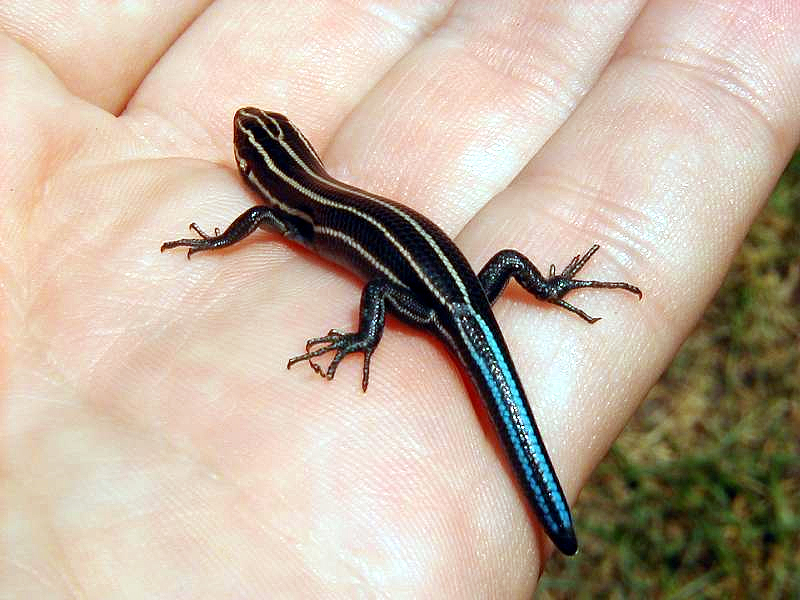|
| 질의: Black cat | 결과: 620번째/674 | |
Five-lined Skink (Eumeces fasciatus) - Wiki
| 제목: | Five-lined Skink (Eumeces fasciatus) - Wiki
| |

| 해상도: 800x600
파일크기: 356394 Bytes
촬영일: 2005:09:04 06:14:54
등록시간: 2007:01:24 09:36:53
|
Five-lined Skink
From Wikipedia, the free encyclopedia
[Photo] Five-lined Skink (Eumeces inexpectatus). Date 2005-09-04. Author Piccolo Namek http://en.wikipedia.org/wiki/User:PiccoloNamek
The Five-lined Skink (Eumeces fasciatus) is one of the most common lizards in the eastern U.S. and one of the five species of lizards in Canada. Other common names include blue-tailed skink and red-headed skink.
Description
It is a small to medium sized skink growing to about 12.5 to 21.5 cm total length (5 to 8.5 inches). Young five-lined skinks are dark brown to black with five distinctive white to yellowish stripes running along the body and a bright blue tail. The blue color fades to grey with age, and the stripes also may slowly disappear. The dark brown color fades, too, and older individuals are often uniformly brownish. The Southeastern five-lined Skink, E. inexpectatus, of the Southeastern United States is very similar to this species and there is some overlap in range. The two species can be told apart based on characters of scales, see photo gallery below. The Broad-headed Skink, E. laticeps, is similar, and may be difficult to distinguish from E. fasciatus. The former species usually lacks the two enlarged postlabial scales characteristic of E. fasciatus (Palmer et al. 1995). Adult male Broad-headed Skinks, with their large size and swollen red head, are readily distinguished from E. fasciatus (Beane 2006).
Range and Habitat
The range of the Five-lined Skink extends in the north to southern Ontario, the lower peninsula of Michigan and eastern New York. The western border is in Wisconsin, Missouri and eastern Kansas, Oklahoma, and Texas. These skinks tend to be most abundant on the coastal plain in the southeastern United States and along the Gulf Coast.
Five-lined Skinks are ground-dwelling animals. They prefer moist, partially wooded habitat that provides ample cover as well as sites to bask in the sun.
Reproduction
The breeding season of the Five-lined Skink is in spring. During this time, males develop an orange coloring of the snout. The females will dig a nest under a log, stump, or rock and lay between 4 an 18 eggs in late spring. She guards the clutch until they hatch. After 24 to 55 days, depending on the ambient temperature, the hatchlings appear.
The mother will consume any unhatched eggs. Five-lined skinks are about two inches in length when born and live for five or six years. Sexual maturity is reached after two to three years.
Predators
Common Predators include raccoons, red foxes, Virginia opossums, snakes, and raptors.
Captive Care
Five-lined skinks can be maintained in captivity with minimal care. A 20-gallon aquarium with a screen lid makes a suitable enclosure for a pair; a larger enclosure will be needed for more than two animals. Never house adult males together as they are very territorial. Place a 1-inch layer of pea gravel on the bottom of the enclosure and cover it with 2-3 inches of topsoil or organic potting soil (be sure to avoid potting soils that contain perlite, vermiculite, foam rubber and fertilizers) mixed with leaf mold and/or coconut bark chips. Give the skinks places to hide using unglazed terra cotta, flat stone or sections of bark. If collecting bark, avoid gathering it from areas where pesticides are used. Place an incandescent light over one end of the enclosure to create a temperature gradient for the skinks. Five-lined skinks like a temperature gradient of 75-80°F on the cool end of their enclosure, 90°F on the warm end. Leave the light on for 12-14 hours per day. The light should be operated using a timer to mimic the natural rising and setting of the sun. Humidity in the skink enclosure should be between 55% and 75%. Mist the enclosure lightly once a day and make sure that the substrate under the shelters remains moist. The rest of the substrate should be allowed to dry out.
For feeding, skinks should be offered live insects. Crickets, mealworms and waxworms obtained from pet stores are good for skinks and many other small lizards. The insects should be gut-loaded before being offered to the skinks: chicken mash is good for this purpose. If chicken mash cannot be obtained, rodent pellets and tropical fish flakes can be offered instead. Dust crickets and other insects with a calcium/D3 supplement to make sure the skinks get enough calcium. This is especially important for juveniles. Offer adult skinks 2-5 insects every other day, while juveniles should be fed daily. Each insect offered to a particular skink should be no more than half the size of the animal's head. Skinks can also be fed canned cat food and chopped fruit as part of a varied diet. Water should be offered in shallow non-metal bowl.
In Canada, the five-lined skink is listed as threatened by both federal and provincial endangered species legislation, and accordingly, it is illegal to capture these animals from the wild, or to harass or kill them.
http://en.wikipedia.org/wiki/Five-lined_Skink
| The text in this page is based on the copyrighted Wikipedia article shown in above URL. It is used under the GNU Free Documentation License. You may redistribute it, verbatim or modified, providing that you comply with the terms of the GFDL. |
^o^
동물그림창고 똑똑전화 누리집
^o^
|
|
|